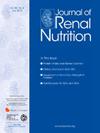诊断血液透析患者营养不良(营养不足和营养过剩)的评估标准。
IF 3.2
3区 医学
Q2 NUTRITION & DIETETICS
引用次数: 0
摘要
目的:本研究旨在确定改编后的营养不良问题全球领导力倡议(GLIM)标准除了能诊断血液透析患者的营养不良外,是否还能诊断营养过剩。此外,该研究还将改编后的 GLIM 标准与用于诊断营养不良的主观全面评估 (SGA) 进行了比较:方法:采用横断面描述性研究设计,并包含分析部分。来自开普敦两家公立肾脏病医院的 116 名成年参与者填写了由访问者主持的调查问卷(IAQ)。数据收集包括人口统计学、医学和人体测量学信息,并结合了既定的 SGA 工具和经调整的 GLIM 标准:结果:58%的参与者为女性,平均年龄为 41.04 岁(标准差 10.6)。肾功能衰竭的主要原因是高血压(38%)和肾小球疾病(33%)。中位体重为 64.74 千克(IQR 16.4),平均体重指数为 25.44 千克/平方米(标清 4.66)。肥胖率为 20%,营养不良率为 4%。来自格罗特舒尔医院(GSH)的参与者的平均体重指数(26.40,标差4.9)高于来自泰格贝格医院(TBH)的参与者(P=0.0033)。腹部肥胖率为 51%,平均腰围为 87.06 厘米(标清 11.37)。使用 SGA 参数,营养不良发生率为 26%,全部归类为 SGA-B,而使用改编 GLIM 则为 22%。经调整的 GLIM 将 69.83% 的人归类为营养不良(营养过剩 47%,营养不良 22%)。对于营养不良,改良版 GLIM 的灵敏度为 75% (CI 64.04, 85.96),特异度为 77.78% (CI 67.26, 88.3),阳性预测值为 69.23% (CI 57.55, 80.91),阴性预测值为 82.35% (CI 72.71, 92.00)。在根据改良版 GLIM 诊断为营养过剩的患者中,89% 的人根据 SGA 被归类为营养良好:结论:改良版 GLIM 标准可有效评估血液透析患者的营养过剩和营养不良情况。在被 SGA 误判为营养良好的患者中,有相当一部分实际上营养过剩。改良后的 GLIM 在诊断该人群的营养不良方面显示出良好的灵敏度和特异性。本文章由计算机程序翻译,如有差异,请以英文原文为准。
Assessment Criteria to Diagnose Malnutrition (Undernutrition and Overnutrition) in Hemodialysis Patients
Objective
This study aimed to determine if adapted Global Leadership Initiative on Malnutrition (GLIM) criteria can diagnose overnutrition, in addition to undernutrition, in hemodialysis patients. Additionally, it compared the adapted GLIM criteria with the subjective global assessment (SGA) for diagnosing undernutrition.
Methods
A cross-sectional, descriptive study design with an analytical component was utilized. An interviewer-administered questionnaire was completed with 116 adult participants from 2 public renal units in Cape Town. Data collection included demographic, medical, and anthropometric information, incorporating the established SGA tool and the adapted GLIM criteria.
Results
Of the participants, 58% were female, with a mean age of 41.04 years (SD 10.6). The primary causes of renal failure were hypertension (38%) and glomerular disease (33%). The median weight was 64.74 kg (IQR 16.4), and the mean body mass index (BMI) was 25.44 kg/m2 (SD 4.66). The prevalence of obesity was 20%, and undernutrition was 4% by BMI. Participants from Groote Schuur Hospital had a higher mean BMI (26.40, SD 4.9) than those from Tygerberg Hospital (P = .0033). Abdominal obesity prevalence was 51%, with a mean waist circumference of 87.06 cm (SD 11.37). Using SGA parameters, undernutrition prevalence was 26%, with all classified as SGA-B, compared to 22% by adapted GLIM. Adapted GLIM classified 69.83% as malnourished (overnutrition 47% and undernutrition 22%). For undernutrition, the adapted GLIM had a sensitivity of 75% (CI 64.04, 85.96), specificity of 77.78% (CI 67.26, 88.3), positive predictive value of 69.23% (CI 57.55, 80.91), and negative predictive value of 82.35% (CI 72.71, 92.00). Among those diagnosed with overnutrition by adapted GLIM, 89% were classified as well-nourished by SGA.
Conclusion
The adapted GLIM criteria effectively assessed overnutrition as well as undernutrition in hemodialysis patients. It identified a significant proportion of patients misclassified as well-nourished by SGA who were actually overnourished. The adapted GLIM showed good sensitivity and specificity for diagnosing undernutrition in this population.
求助全文
通过发布文献求助,成功后即可免费获取论文全文。
去求助
来源期刊

Journal of Renal Nutrition
医学-泌尿学与肾脏学
CiteScore
5.70
自引率
12.50%
发文量
146
审稿时长
6.7 weeks
期刊介绍:
The Journal of Renal Nutrition is devoted exclusively to renal nutrition science and renal dietetics. Its content is appropriate for nutritionists, physicians and researchers working in nephrology. Each issue contains a state-of-the-art review, original research, articles on the clinical management and education of patients, a current literature review, and nutritional analysis of food products that have clinical relevance.
 求助内容:
求助内容: 应助结果提醒方式:
应助结果提醒方式:


